Daily Goals During Interdisciplinary Rounds: Slide Presentation
AHRQ Safety Program for Mechanically Ventilated Patients
Slide 1: AHRQ Safety Program for Mechanically Ventilated Patients
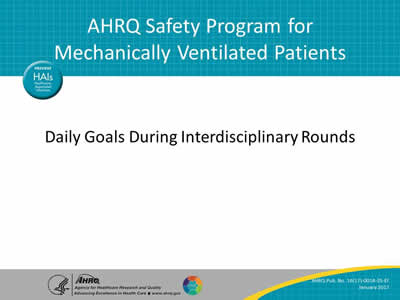
Daily Goals During Interdisciplinary Rounds
Slide 2: Learning Objectives
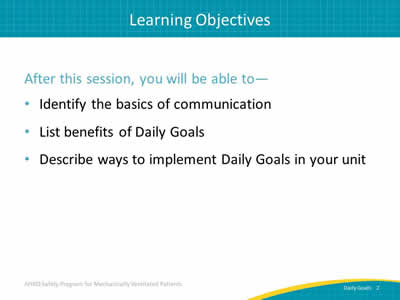
After this session, you will be able to—
- Identify the basics of communication.
- List benefits of Daily Goals.
- Describe ways to implement Daily Goals in your unit.
Slide 3: Basic Components and Process of Communication

Image: Graphic description of the basic components and process of communication between two people and how communication is exposed to many roadblocks.
Slide 4: Why Communication Matters1
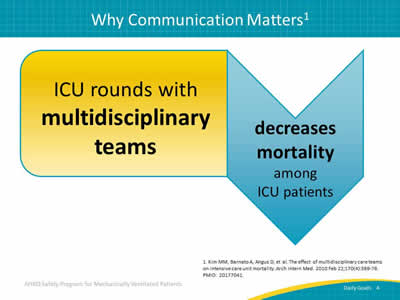
Image: ICU rounds with multidisciplinary teams decreases mortality among ICU patients.
1. Kim MM, Barnato A, Angus D, et al. The effect of multidisciplinary care teams on intensive care unit mortality. Arch Intern Med 2010 Feb 22;170(4):369-76. PMID: 20177041.
Slide 5: Why Communication Matters
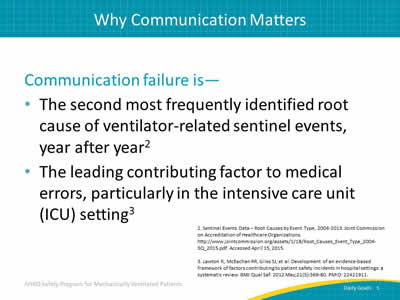
Communication failure is—
- The second most frequently identified root cause of ventilator-related sentinel events, year after year.2
- The leading contributing factor to medical errors, particularly in the intensive care unit (ICU) setting.3
2. Sentinel Events Data – Root Causes by Event Type, 2004-2013. Joint Commission on Accreditation of Healthcare Organizations. http://www.jointcommission.org/assets/1/18/Root_Causes_Event_Type_2004-3Q_2015.pdf. Accessed April 15, 2015.
3. Lawton R, McEachan RR, Giles SJ, et al. Development of an evidence-based framework of factors contributing to patient safety incidents in hospital settings: a systematic review. BMJ Qual Saf 2012 May;21(5):369-80. PMID: 22421911.
Slide 6: Why Communication Matters
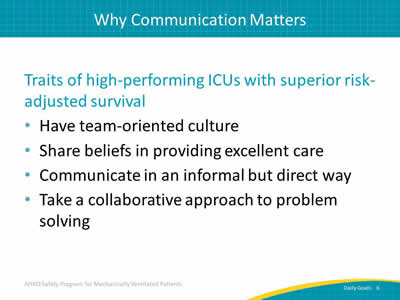
Traits of high-performing ICUs with superior risk-adjusted survival:
- Have team-oriented culture.
- Share beliefs in providing excellent care.
- Communicate in an informal but direct way.
- Take a collaborative approach to problem solving.
Slide 7: Barriers That Impact Communication
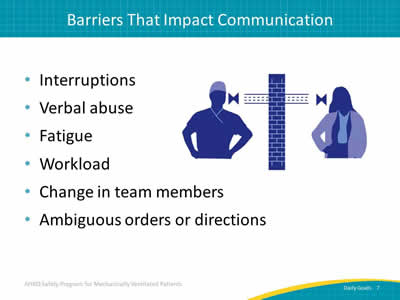
- Interruptions.
- Verbal abuse.
- Fatigue.
- Workload.
- Change in team members.
- Ambiguous orders or directions.
Image: Team members separated by barrier representing possible challenges to effective communication.
Slide 8: Communication Breakdowns Cause Sentinel Events
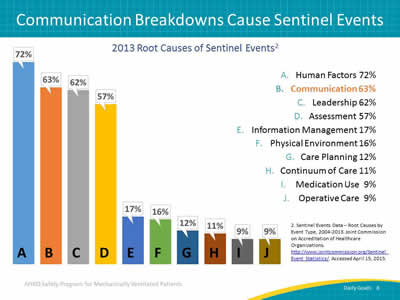
Image: Bar graph illustrating the root causes of sentinel events and highlighting communication as the second highest factor at 63 percent.
2013 Root Causes of Sentinel Events:2
- Human Factors 72%.
- Communication 63%.
- Leadership 62%.
- Assessment 57%.
- Information Management 17%.
- Physical Environment 16%.
- Care Planning 12%.
- Continuum of Care 11%.
- Medication Use 9%.
- Operative Care 9%.
2. Sentinel Events Data – Root Causes by Event Type, 2004-2013. Joint Commission on Accreditation of Healthcare Organizations. http://www.jointcommission.org/assets/1/18/Root_Causes_Event_Type_2004-3Q_2015.pdf. Accessed April 15, 2015.
Slide 9: Benefits of Daily Goals
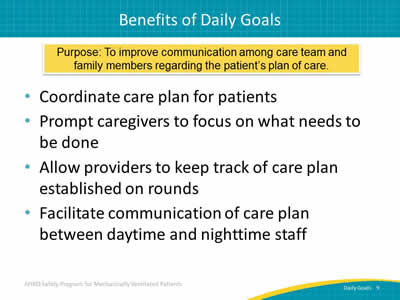
Purpose: To improve communication among care team and family members regarding the patient’s plan of care.
- Coordinate care plan for patients.
- Prompt caregivers to focus on what needs to be done.
- Allow providers to keep track of care plan established on rounds.
- Facilitate communication of care plan between daytime and nighttime staff.
Slide 10: Daily Goals and Outcomes
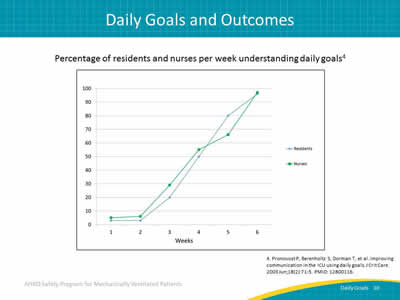
Percentage of residents and nurses per week understanding daily goals4
Image: Line graph illustrating the percentage of residents and nurses understanding daily goals increasing to almost 100 percent in 6 weeks.
4. Pronovost P, Berenholtz S, Dorman T, et al. Improving communication in the ICU using daily goals. J Crit Care 2003 Jun;18(2):71-5. PMID: 12800116.
Slide 11: Daily Goals and Outcomes
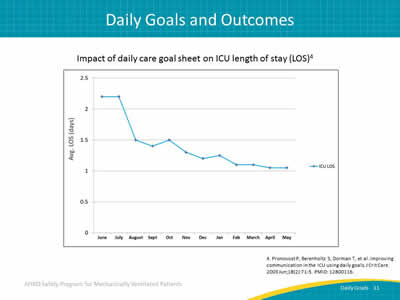
Impact of daily care goal sheet on ICU length of stay (LOS)4
Image: Line graph illustrating how the ICU length of stay reduces by more than a day using the daily care goal sheet.
4. Pronovost P, Berenholtz S, Dorman T, et al. Improving communication in the ICU using daily goals. J Crit Care 2003 Jun;18(2):71-5. PMID: 12800116.
Slide 12: Conventional Rounds

- Encounter communication defects frequently.
- Are provider- rather than patient-centered.
- Use divergent discussion (brainstorming) rather than convergent discussion (explicit plan).
- Prevent effective real-time or future feedback regarding plan of care.
Slide 13: Rounds With Daily Goals
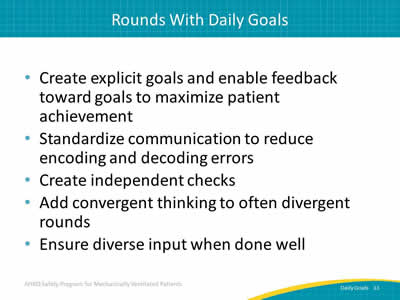
- Create explicit goals and enable feedback toward goals to maximize patient achievement.
- Standardize communication to reduce encoding and decoding errors.
- Create independent checks.
- Add convergent thinking to often divergent rounds.
- Ensure diverse input when done well.
Slide 14: Daily Goals Improve Communication and Care
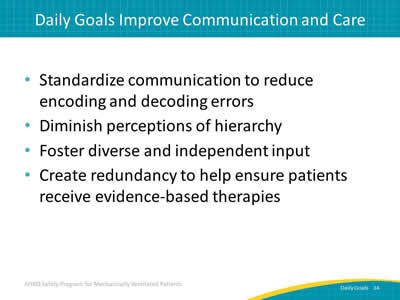
- Standardize communication to reduce encoding and decoding errors.
- Diminish perceptions of hierarchy.
- Foster diverse and independent input.
- Create redundancy to help ensure patients receive evidence-based therapies.
Slide 15: Using Daily Goals
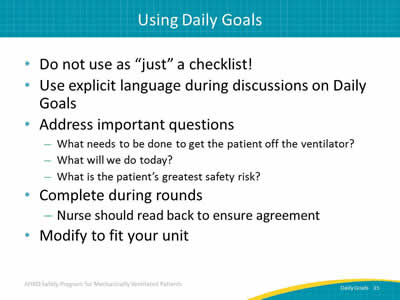
- Do not use as "just" a checklist!
- Use explicit language during discussions on Daily Goals.
- Address important questions:
- What needs to be done to get the patient off the ventilator?
- What will we do today?
- What is the patient’s greatest safety risk?
- Complete during rounds:
- Nurse should read back to ensure agreement.
- Modify to fit your unit.
Slide 16: Evidence Favoring Daily Goals
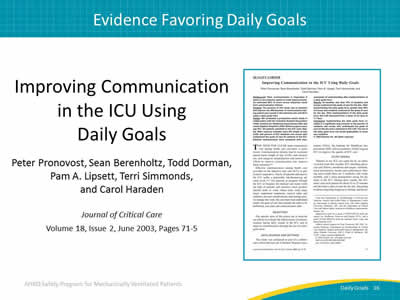
Improving Communication in the ICU Using Daily Goals
Peter Pronovost, Sean Berenholtz, Todd Dorman, Pam A. Lipsett, Terri Simmonds, and Carol Haraden
Journal of Critical Care
Volume 18, Issue 2, June 2003, Pages 71-5
Image: First page of the "Improving Communication in the ICU Using Daily Goals" article in the Journal of Critical Care Medicine.
Slide 17: Evidence Favoring Daily Goals
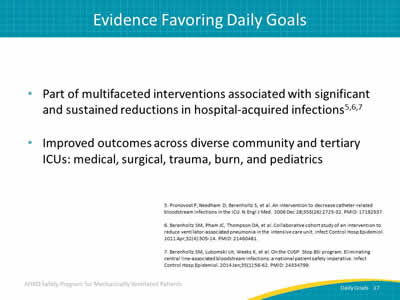
- Part of multifaceted interventions associated with significant and sustained reductions in hospital-acquired infections.5,6,7
- Improved outcomes across diverse community and tertiary ICUs: medical, surgical, trauma, burn, and pediatrics.
5. Pronovost P, Needham D, Berenholtz S, et al. An intervention to decrease catheter-related bloodstream infections in the ICU. N Engl J Med 2006 Dec 28;355(26):2725-32. PMID: 17192537.
6. Berenholtz SM, Pham JC, Thompson DA, et al. Collaborative cohort study of an intervention to reduce ventilator-associated pneumonia in the intensive care unit. Infect Control Hosp Epidemiol 2011 Apr;32(4):305-14. PMID: 21460481.
7. Berenholtz SM, Lubomski LH, Weeks K, et al. On the CUSP: Stop BSI program. Eliminating central line-associated bloodstream infections: a national patient safety imperative. Infect Control Hosp Epidemiol 2014 Jan;35(1):56-62. PMID: 24334799.
Slide 18: Evidence Favoring Daily Goals
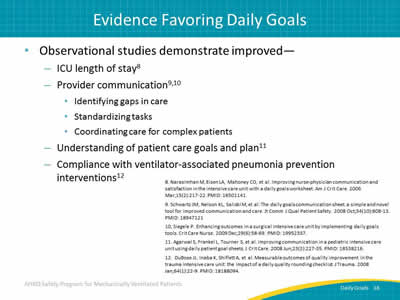
- Observational studies demonstrate improved—
- ICU length of stay.8
- Provider communication:9,10
- Identifying gaps in care.
- Standardizing tasks.
- Coordinating care for complex patients.
- Understanding of patient care goals and plan.11
- Compliance with ventilator-associated pneumonia prevention interventions.12
8. Narasimhan M, Eisen LA, Mahoney CD, et al. Improving nurse-physician communication and satisfaction in the intensive care unit with a daily goals worksheet. Am J Crit Care 2006 Mar;15(2):217-22. PMID: 16501141.
9. Schwartz JM, Nelson KL, Saliski M, et al. The daily goals communication sheet: a simple and novel tool for improved communication and care. Jt Comm J Qual Patient Safety 2008 Oct;34(10):608-13. PMID: 18947121
10, Siegele P. Enhancing outcomes in a surgical intensive care unit by implementing daily goals tools. Crit Care Nurse 2009 Dec;29(6):58-69. PMID: 19952337.
11. Agarwal S, Frankel L, Tourner S, et al. Improving communication in a pediatric intensive care unit using daily patient goal sheets. J Crit Care 2008 Jun;23(2):227-35. PMID: 18538216.
12. DuBose JJ, Inaba K, Shiflett A, et al. Measurable outcomes of quality improvement in the trauma intensive care unit: the impact of a daily quality rounding checklist. J Trauma 2008 Jan;64(1):22-9. PMID: 18188094.
Slide 19: What Is Next? Preparing for Daily Goals
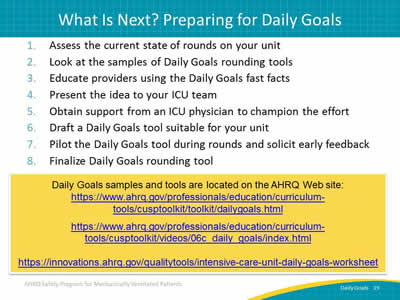
- Assess the current state of rounds on your unit.
- Look at the samples of Daily Goals rounding tools.
- Educate providers using the Daily Goals fast facts.
- Present the idea to your ICU team.
- Obtain support from an ICU physician to champion the effort.
- Draft a Daily Goals tool suitable for your unit.
- Pilot the Daily Goals tool during rounds and solicit early feedback.
- Finalize Daily Goals rounding tool.
Daily Goals samples and tools are located on the AHRQ Web site:
https://www.ahrq.gov/professionals/education/curriculum-tools/cusptoolkit/toolkit/dailygoals.html
https://innovations.ahrq.gov/qualitytools/intensive-care-unit-daily-goals-worksheet
Slide 20: What Is the State of Rounds on Your Unit?
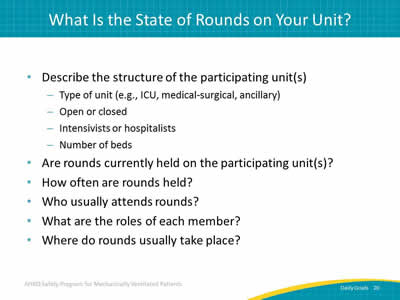
- Describe the structure of the participating unit(s):
- Type of unit (e.g., ICU, medical-surgical, Ancillary).
- Open or closed.
- Intensivists or hospitalists.
- Number of beds.
- Are rounds currently held on the participating unit(s)?
- How often are rounds held?
- Who usually attends rounds?
- What are the roles of each member?
- Where do rounds usually take place?
Slide 21: What Is the State of Rounds on Your Unit?
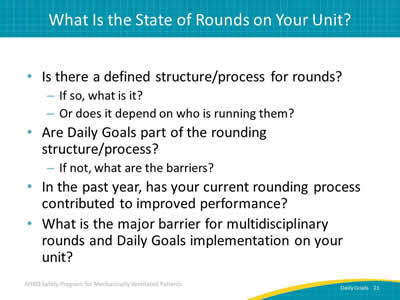
- Is there a defined structure/process for rounds?
- If so, what is it?
- Or does it depend on who is running them?
- Are Daily Goals part of the rounding structure/process?
- If not, what are the barriers?
- In the past year, has your current rounding process contributed to improved performance?
- What is the major barrier for multidisciplinary rounds and Daily Goals implementation on your unit?
Slide 22: References
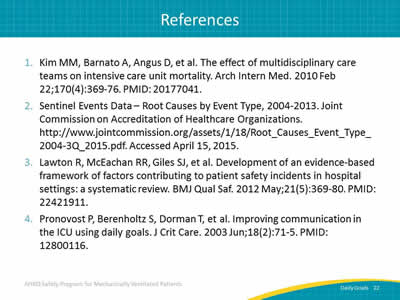
1. Kim MM, Barnato A, Angus D, et al. The effect of multidisciplinary care teams on intensive care unit mortality. Arch Intern Med 2010 Feb 22;170(4):369-76. PMID: 20177041.
2. Sentinel Events Data – Root Causes by Event Type, 2004-2013. Joint Commission on Accreditation of Healthcare Organizations. http://www.jointcommission.org/assets/1/18/Root_Causes_Event_Type_2004-3Q_2015.pdf. Accessed April 15, 2015.
3. Lawton R, McEachan RR, Giles SJ, et al. Development of an evidence-based framework of factors contributing to patient safety incidents in hospital settings: a systematic review. BMJ Qual Saf 2012 May;21(5):369-80. PMID: 22421911.
4. Pronovost P, Berenholtz S, Dorman T, et al. Improving communication in the ICU using daily goals. J Crit Care 2003 Jun;18(2):71-5. PMID: 12800116.
Slide 23: References
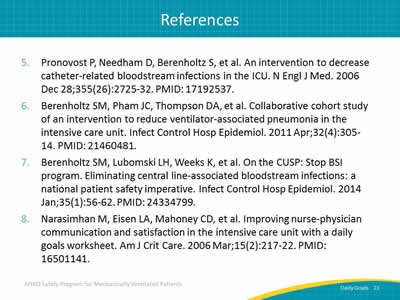
5. Pronovost P, Needham D, Berenholtz S, et al. An intervention to decrease catheter-related bloodstream infections in the ICU. N Engl J Med 2006 Dec 28;355(26):2725-32. PMID: 17192537.
6. Berenholtz SM, Pham JC, Thompson DA, et al. Collaborative cohort study of an intervention to reduce ventilator-associated pneumonia in the intensive care unit. Infect Control Hosp Epidemiol 2011 Apr;32(4):305-14. PMID: 21460481.
7. Berenholtz SM, Lubomski LH, Weeks K, et al. On the CUSP: Stop BSI program. Eliminating central line-associated bloodstream infections: a national patient safety imperative. Infect Control Hosp Epidemiol 2014 Jan;35(1):56-62. PMID: 24334799.
8. Narasimhan M, Eisen LA, Mahoney CD, et al. Improving nurse-physician communication and satisfaction in the intensive care unit with a daily goals worksheet. Am J Crit Care 2006 Mar;15(2):217-22. PMID: 16501141.
Slide 24: References
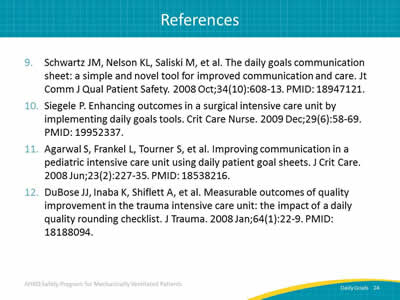
9. Schwartz JM, Nelson KL, Saliski M, et al. The daily goals communication sheet: a simple and novel tool for improved communication and care. Jt Comm J Qual Patient Safety 2008 Oct;34(10):608-13. PMID: 18947121
10, Siegele P. Enhancing outcomes in a surgical intensive care unit by implementing daily goals tools. Crit Care Nurse 2009 Dec;29(6):58-69. PMID: 19952337.
11. Agarwal S, Frankel L, Tourner S, et al. Improving communication in a pediatric intensive care unit using daily patient goal sheets. J Crit Care 2008 Jun;23(2):227-35. PMID: 18538216.
12. DuBose JJ, Inaba K, Shiflett A, et al. Measurable outcomes of quality improvement in the trauma intensive care unit: the impact of a daily quality rounding checklist. J Trauma 2008 Jan;64(1):22-9. PMID: 18188094.



